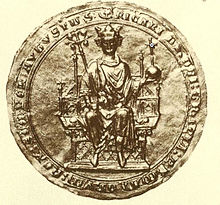you may even go so far as to consider him a bit of a hero, and maybe he was, but as far as his connections with Cornwall
are concerned he was also manipulative and greedy. Richard of Cornwall was born the second son of King John and Isabella
of Angouleme on the 5th January 1209, he was just fifteen months younger than his more famous brother, King Henry III.
he was given the Earldom of Cornwall. Many of the events of Richard's life were centred around Cornwall, and it was from
his castle at Launceston that he and his men left for the battle of Lewes in 1264.
In Richard's early years he had been a supporter of the barons who were in opposition to the king, Henry paid him at
least three times to come back into the fold. However, after the death in 1240 of his first wife Isabel Marshall, daughter of
William Marshall, there was a change in Richard. This began with his marriage, in the November of 1242 to Sanchia
of Provence, the sister of Henry's queen, after which he became one of his brother's greatest supporters, although he was
not in agreement with the king on certain points. In 1257 he was crowned King of the Romans at Aachen, it was his
wealth, according to writings at the time, that enabled him to pay for enough votes to secure the title.
Thritti thousant pounds askede he
For to make the pees in the countre
of Cornwall where he liked to pursue his hobby of collecting castles, and where, unlike previous Norman overlords, Richard
spent much of his time. His main residence was at Launceston where he built his mighty round tower and also spent time
and money rebuilding the castle walls and gatehouses. Not only did Richard take a few bribes, he was not opposed
to throwing his weight around and issuing threats. In 1236 he had his eye on Tintagel, whose castle and lands King John
had granted to Gervase de Hornicote. Under the threat of violence but in the guise of an exchange, Richard received
Tintagel from Hornicote's heir. In much the same manner he pursuaded the Cardinaham heiress to part with her large estates
at Bodmin and Lostwithiel to her 'most serene prince and lord.'
last Norman overlords, de Valletort family. Richard managed to purchase this castle in 1270, how he managed this is
unknown, but it has to be pointed out that Valletort's wife Joan, was Richard's mistress, and by whom, he had at least
five children.
conform and used underhand tactics to get what he wanted from others. Unwanted in Germany, Richard died on the 2nd
April 1272 at Berkhamsted Castle, a quasi king in his own little West Country kingdom where he was not much liked.
Richard, Earl of Cornwall died the age of sixty after suffering stroke that left him paralysed on one side and unable to speak.
He was buried at Hailes Abbey which he founded.





 RSS Feed
RSS Feed
